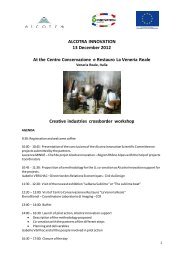Best practices Database for Living Labs - ALCOTRA - Innovation
Best practices Database for Living Labs - ALCOTRA - Innovation
Best practices Database for Living Labs - ALCOTRA - Innovation
You also want an ePaper? Increase the reach of your titles
YUMPU automatically turns print PDFs into web optimized ePapers that Google loves.
(from a public authority’s viewpoint) local innovation policies and strategies. An evaluative ‘feedback loop’<br />
from this third layer to the PPP on the top is key to ensure not only the eventual replication of the trial at<br />
the same or another future stage, but also a collective, shared and transparent evaluation of the results<br />
obtained. This is another essential feature of the <strong>Living</strong> <strong>Labs</strong> approach, well in line with the principles of<br />
Open <strong>Innovation</strong>, but also a guarantee <strong>for</strong> taxpayer’s money expenditure, provided that most stakeholders<br />
do belong to the public sector.<br />
The relevance of the strategic layer is confirmed by the evidence collected in 2008 within the ‘1 st and 2 nd<br />
wave’ members of the European Network of <strong>Living</strong> <strong>Labs</strong> [13], which showed how in 8 out of 10 cases, their<br />
essence (or raison d’être) pointed at the creation of innovative places (milieux) <strong>for</strong> territorial marketing and<br />
business (or SME) promotion, thus adding to the plethora of territorial innovation policy instruments. This<br />
evidence can only be partly explained by a prevalence of government stakeholders (in 35% of the cases,<br />
according to the 2008 survey) within the <strong>Living</strong> <strong>Labs</strong> PPPP’s. More generally, it stems from the shared<br />
intuition that by leveraging on the positive externalities of user-driven, open innovation, a bigger share of<br />
product and service inventions can actually reach the market, which in turn leads to the creation of a more<br />
favourable and conducive environment to entrepreneurship and business development, not to speak of<br />
employment and social cohesion.<br />
In this context, it comes with little surprise that the majority of the <strong>Living</strong> <strong>Labs</strong>’ thematic domains surveyed<br />
in 2008 was belonging to Government and Public Administration on the one hand, and to SME-specific<br />
industrial applications on the other hand (see Figure 2).<br />
Figure 2: Overview of <strong>Living</strong> <strong>Labs</strong> domains - 2008 (from: [13])<br />
In the above respect, the <strong>Living</strong> Lab approach presents itself as a new model of territorial innovation in<br />
which the local institutional dynamics play a significant role [14]. This is achieved via a novel and reportedly<br />
successful ‘mixture’ of ICT-based collaboration, open innovation, people (user) integration in the design<br />
process [15] and public private partnerships, as the following table shows in more detail:<br />
The project is co-funded by the ERDF<br />
Page 11 of 78









